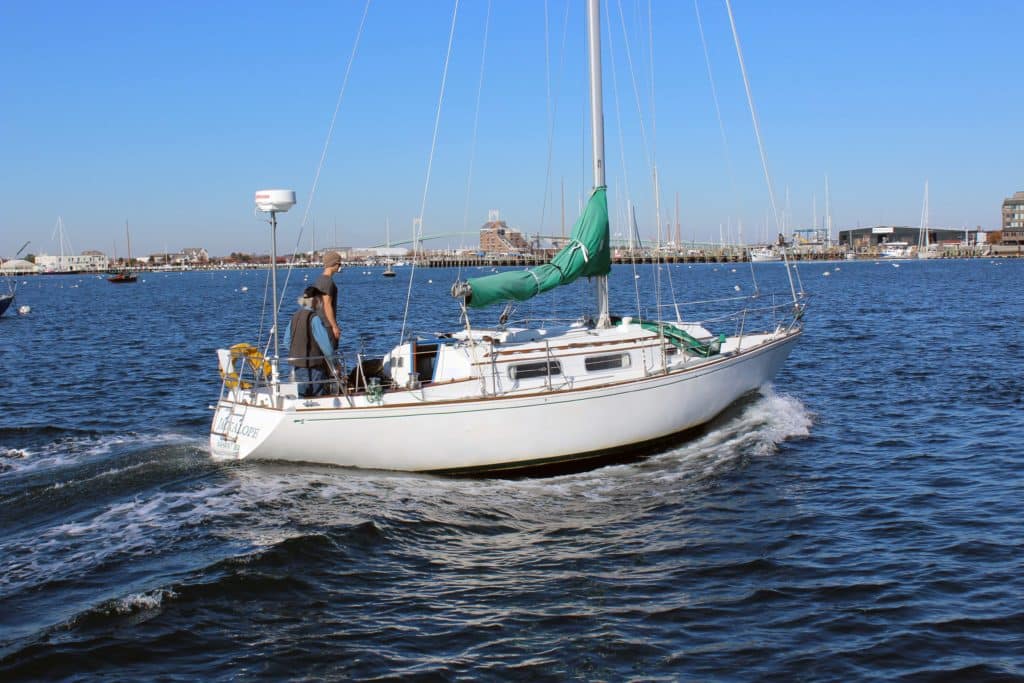
When we bought our 1978 Sabre 34, Jackalope, 13 years ago, the previous owner reported that the diesel occasionally ran hot. His broker described it as a plus: We could look forward to nice warm showers at the end of a long day on the water. Hmm.
Indeed, during sea trials, the mechanic determined that the cooling ports in the seawater-cooled Volvo MD11 were clogged, a condition that could be corrected only by dismantling the beast and giving it a thorough cleaning out, which the owner agreed to do as part of the sale.
For our first few seasons, the Volvo proved to be a dependable little workhorse. It started reliably, pushed the boat along well enough, and its temperature needle sat squarely between the “E” and the “M” on the TEMP gauge. Eventually, though, I noticed that each season, the needle veered a little further off center, first past the “M” and soon past the “P.” Then, two summers ago, it pegged itself at the end of the dial, firmly on the dreaded “H,” for “hot,” which spelled nothing but trouble.
Hoping to avoid another $2,000 to $3,000 dismantling of a 37-year-old engine, I tried tinkering with hoses and even flushed the Volvo with all manner of elixirs, but to no avail. With the exception of one short ride around the harbor, we were mooring-bound for the season.
As summer slipped by, we examined our options. Already I’d noticed that finding parts for the Volvo was becoming more difficult. Besides, the idea of rebuilding an engine rusting from the inside out didn’t seem wise. With a little hunting, I located a supposedly working replacement in a nearby yard, but the thought of trading our current set of problems for another old bucket of bolts didn’t instill confidence in my wife, who’d had her fill of motor-inspired calamities.
Finally, we concluded that the only real choice was to dig deep (with a tremendous groan) and repower. Our search began and ended at the Newport Boat Show, where we decided to go with a new Yanmar. The brand has earned a solid reputation, and just as important, Oldport Marine, the Newport, Rhode Island, Yanmar dealer, came well recommended as an installer.
At the time, Yanmar was running a promotion that included a new raw-water strainer, hoses and a muffler, but we were forewarned that we’d need to replace the propeller to accommodate the rotation direction of the new engine. Oldport’s Matt Gineo also cautioned that there might be some surprises when the work began, and suggested we budget somewhere in the $18,000 to $19,000 ballpark just in case. Offsetting those costs was the fact that they’d do the job at Oldport’s dock, with the boat in the water, eliminating the expense of hauling and storage.
In all, the job required 52 hours of work. First the Volvo was removed, along with all the old hoses, wiring and instruments. The Sabre’s engine beds had to be modified, but the mechanic was able to sister in new boards on each side, trim them slightly, and glass the new beds in place in a fairly straightforward manner.
While the motor was out, he painted the entire engine space, cleaned up some unrelated wiring, and moved our freshwater pump from its mount under the cockpit into an interior locker to reduce the chance of it freezing up, as it had on occasion during the past few winters.
The only real surprise came when he removed the prop shaft and discovered that someone over the years had used the wrong size hose on our stuffing box. The hose had been heated and then stretched to fit the shaft log; it’s a wonder it hadn’t failed completely.
It was a happy day when I got the call announcing Jackalope was ready for sea trials. The new Yanmar roared to life at the touch of a button, and water, glorious water, literally spewed from the new exhaust through-hull. In the harbor, we ran the engine at various rpm, the once-sluggish control cables now sliding smoother than silk. Wide open, Jackalope cracked 7 knots with ease, a speed that was unthinkable with the old motor.
To be honest, I went into the repower with trepidation and a tinge of buyer’s remorse. That all immediately disappeared as soon as I shifted the engine into gear. It felt spectacular — like driving a brand-new boat.
We gladly paid the balance of our bill, which came in slightly below Oldport’s just-in-case estimate. And I have to say that those are some of the best dollars we’ve spent. Last summer, hallelujah, we had a boat again.








